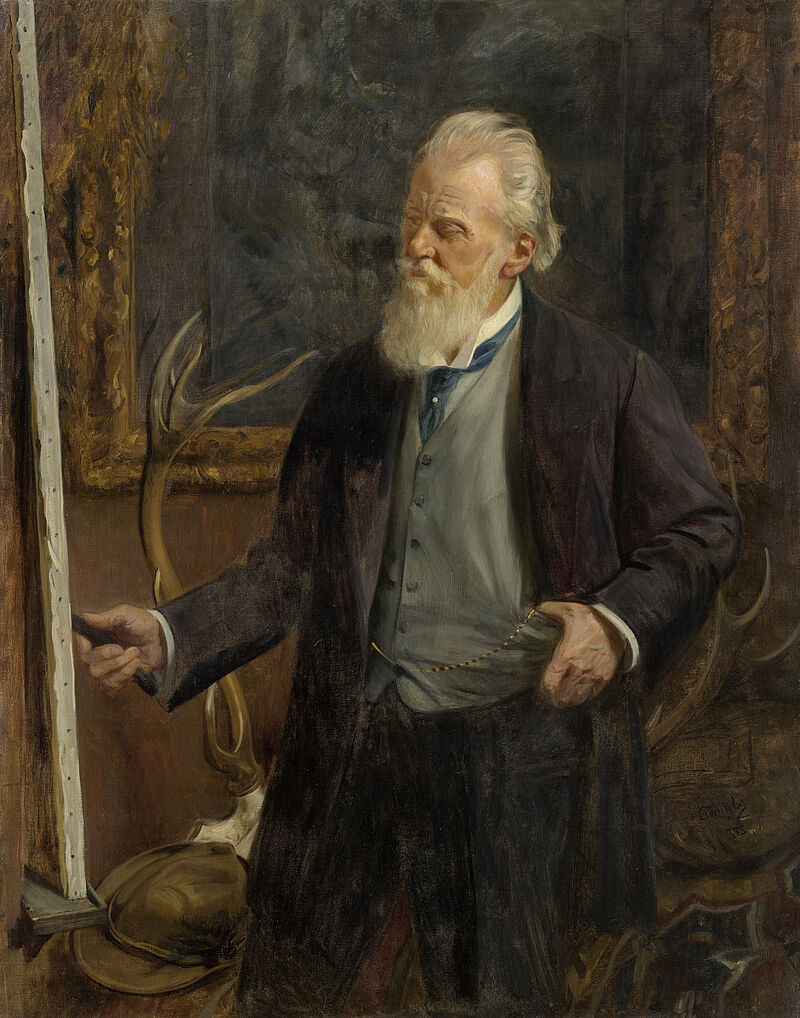Franz Xaver von Pausinger (1839 Salzburg-1915 Salzburg )
Framesize 168.00 x 137.50 x 9.10 cm
In a prestigious life-size knee-length portrait, Temple presents Franz Xaver von Pausinger as befits a painter-prince, as a well-groomed, well-dressed painter personality. Pausinger’s success was based on his sketches for Crown Prince Rudolf’s Journey to the Orient. Frequent participation in court hunting-parties brought him countless commissions from the high aristocracy. His face, in three-quarter profile, is turned towards the painting in progress. His pose, with his left hand hooked into his waistcoat pocket, suggests a certain nonchalance towards his work. The attributes of antlers, framed painting of game animals and hat with twig indicate his profession of animal painter. The twig shows that Pausinger was familiar with hunting, which offered him the opportunity of observing animals, as in his own hunting-ground in Weyregg am Attersee. The headstone on his grave of honour in Salzburg’s municipal cemetery bears the inscription: “Franz von Pausinger / 10.2.1839 – 7.4.1915 / animal painter / art and work were his life / his spirit lives on in his works” – as for instance Stag hunt, Hay harvest and Cow in the Residenzgalerie (inv. nos. 296, 481, 492) or the Pausinger collection in Salzburg Museum.
Temple’s portrait of the artist is evidently based on two photographs. In 1892, Albert Kuhn took a series of photographs of Pausinger’s studio. The interior photographs presumably show the premises in the attic of Schloss Elsenheim, furnished in Makart style, not the painter’s studio in the Salzburg Künstlerhaus. In one of the photographs, Pausinger stands with palette and brushes in front of a large-format game piece. The artist’s pose in front of a characteristic work is strikingly reminiscent of the painting executed 21 years later; the antlers, too, are shown in the oil painting. The pose of the somewhat older artist is that in a photograph taken by Carl Ellinger, in which the antlers are missing, and the game piece is replaced with a mirror showing a further view of the artist. The position and ornamentation of the mirror correspond to those of the game piece in the painting.
Ducke Astrid: Atelierszenen I Studio scenes. In: Ducke Astrid, Habersatter Thomas (Hrsg. I Ed.): Face to Face. Österreichische Porträtmalerei des 19. Jahrhunderts. 19th-century Austrian portrait painting. Residenzgalerie Salzburg I DomQuartier Salzburg 6.6.-29.9.2025. Salzburg 2025, S. I p. 77-79, Abb. I Illus. 4-6
Download of this artwork is permitted for private use only.
Here you will find our license for non-commercial use.


